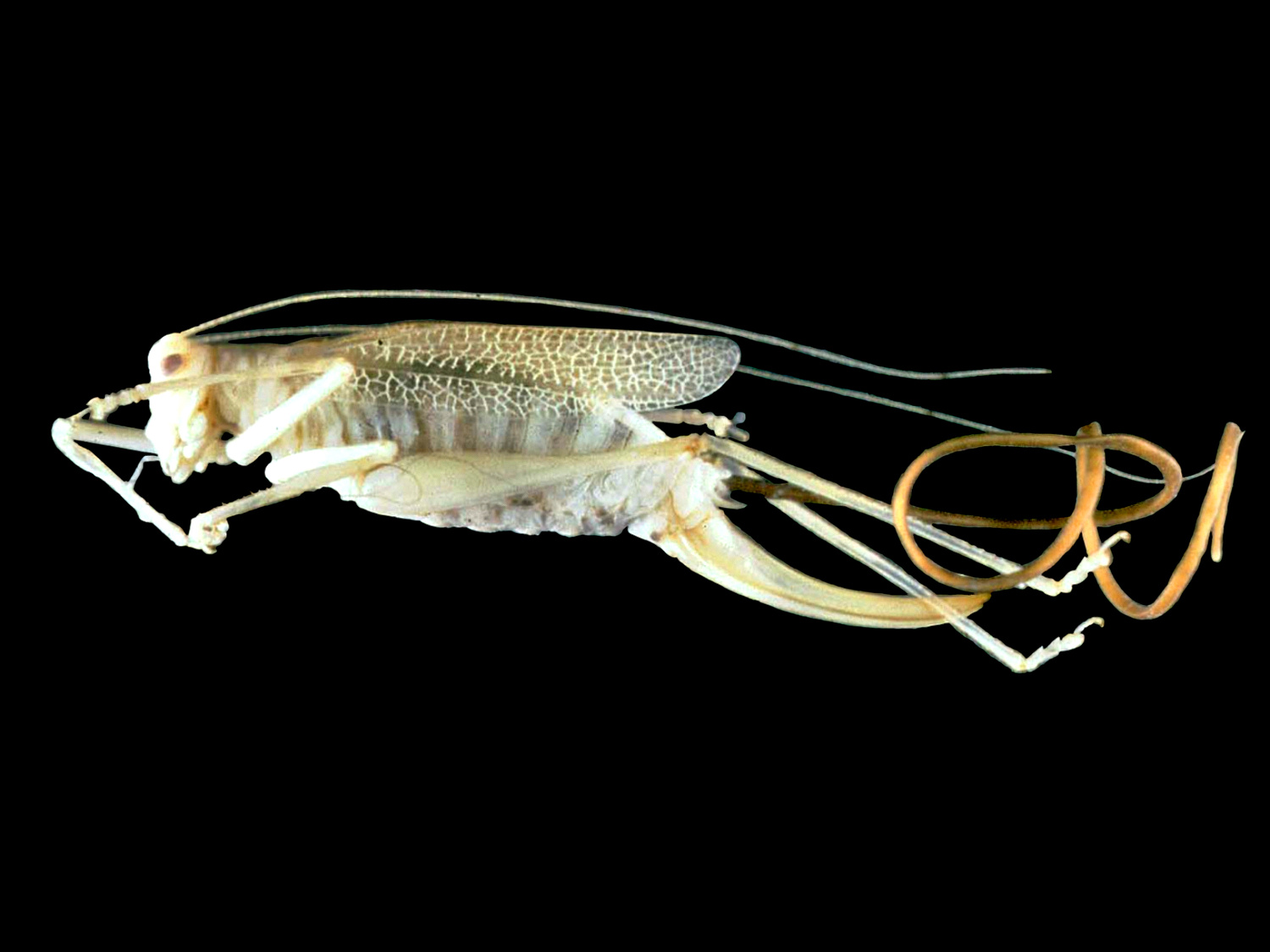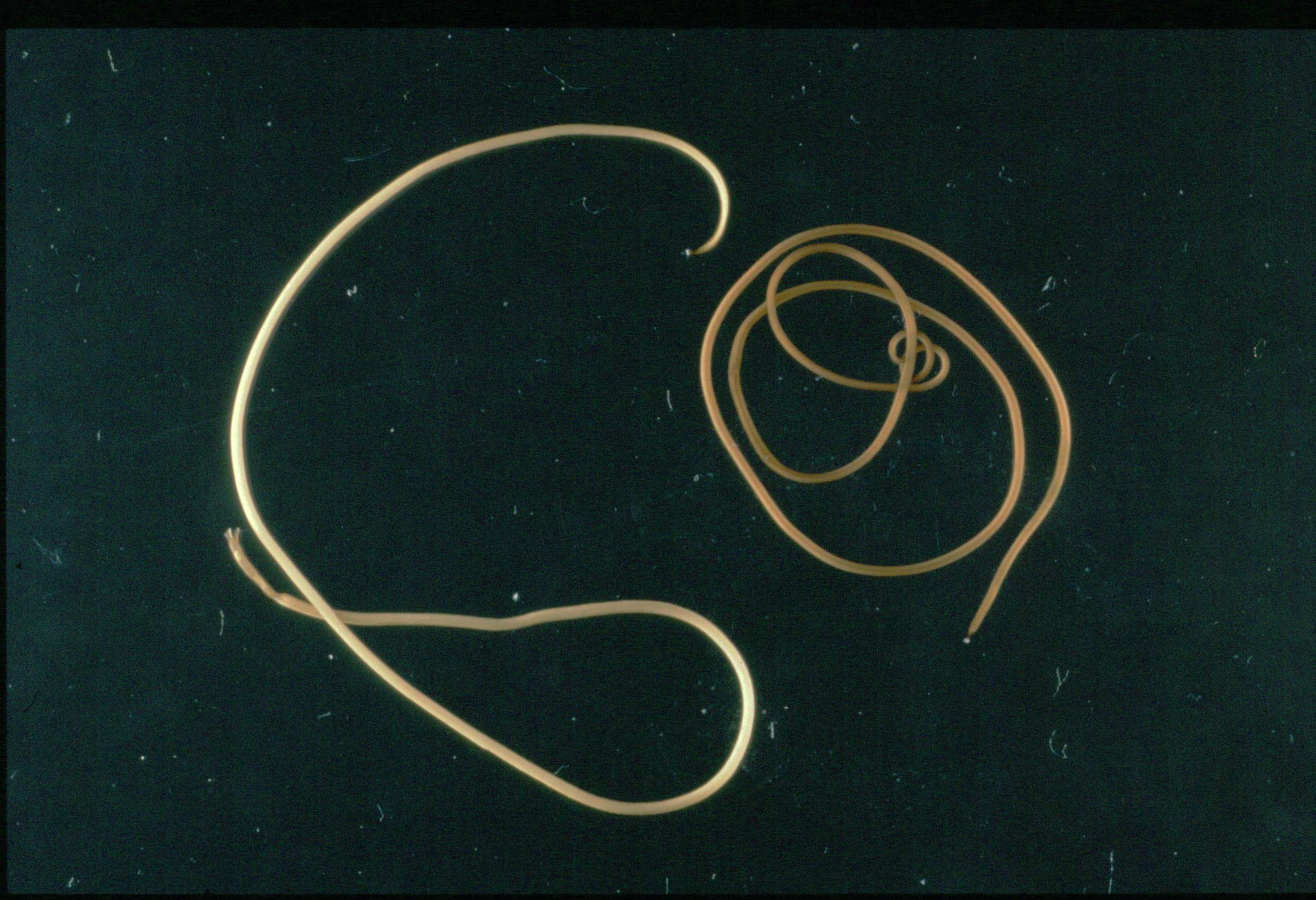|
Gordioidea
Gordioidea is an order (biology), order (sometimes placed at superfamily level) of parasitic Nematomorpha, horsehair worms. Its taxonomy remains uncertain, but appears to be contained in the monotypic class Gordioida and contains about 320 known species. Biology Gordioidean adults are free-living in freshwater or semi-terrestrial habitats and larvae parasitise insects, primarily Orthopterans. Unlike Nectonematoideans, which are marine, gordioideans lack lateral rows of setae and have a single, ventral epidermal cord and their blastocoel is filled with mesenchyme in young worms but become open when older.Pechenik (2010) ''Biology of the Invertebrates'', p. 457. Families and genera The Integrated Taxonomic Information System lists the following genera in two families: Chordodidae Auth. May, 1919; selected genera: ;Subfamily Chordodinae Heinze, 1935 * ''Chordodes'' Creplin, 1847 * ''Dacochordodes'' Capuse, 1965 * ''Euchordodes'' Heinze, 1937 * ''Neochordodes'' Carvalho, 1942 * '' ... [...More Info...] [...Related Items...] OR: [Wikipedia] [Google] [Baidu] |
Nematomorpha
Nematomorpha (sometimes called Gordiacea, and commonly known as horsehair worms, hairsnakes, or Gordian worms) are a phylum of parasitoid animals superficially similar to nematode worms in morphology, hence the name. Most species range in size from , reaching in extreme cases, and in diameter. Horsehair worms can be discovered in damp areas, such as watering troughs, swimming pools, streams, puddles, and cisterns. The adult worms are free-living, but the larvae are parasitic on arthropods, such as beetles, cockroaches, mantises, orthopterans, and crustaceans. About 351 freshwater species are known and a conservative estimate suggests that there may be about 2000 freshwater species worldwide. The name "Gordian" stems from the legendary Gordian knot. This relates to the fact that nematomorphs often coil themselves in tight balls that resemble knots. Description and biology Nematomorphs possess an external cuticle without cilia. Internally, they have only longitudinal muscle and ... [...More Info...] [...Related Items...] OR: [Wikipedia] [Google] [Baidu] |
Nectonematoidea
''Nectonema'' is a genus of marine Nematomorpha, horsehair worms first described by Addison Emery Verrill, Addison E. Verrill in 1879. It is the only genus in the family Nectonematidae described by Henry Baldwin Ward, Henry B. Ward in 1892, in the order Nectonematoidea, and in the class Nectonematoida. The genus contains five species; all species have a Parasitism, parasitic Larva, larval stage inhabiting crustacean hosts and a free-living adult stage that swims in open water. Taxonomy Nectonematoidea is one of two orders within the phylum Nematomorpha, the other being Gordioidea. The latter is likewise in a single class Gordioida, which is a significantly larger taxon, with over 300 known species. Nematomorpha are known as horsehair worms or Gordian worms, and form a sister-group to the nematodes. The following classification shows the place of Nectonematoida within the protostomes according to Minelli (2008) and Tedersoo (2017): Within Nectonematoida only a single genus, ''Ne ... [...More Info...] [...Related Items...] OR: [Wikipedia] [Google] [Baidu] |
Gordius (worm)
''Gordius'' is a genus of worms in the phylum Nematomorpha, the horsehair worms. It was formerly treated as the only genus in the family Gordiidae, but the genus '' Acutogordius'' is now considered as distinct.Bleidorn, C., et al. (2002)Systematic relationships of Nematomorpha based on molecular and morphological data. ''Invertebrate Biology'' 121(4), 357-64. The genus is distributed worldwide except for Antarctica, where no Nematomorpha have been recorded.Schmidt-Rhaesa, A. (2002)Are the genera of Nematomorpha monophyletic taxa? ''Zoologica Scripta'' 31(2), 185-200. Description The adult worm is a free-living animal. It is hairlike, very long and very thin. It commonly grows over a meter long,Capinera, J. LHorsehair Worms, Hairworms, Gordian Worms, Nematomorphs, ''Gordius'' spp. (Nematomorpha: Gordioidea). EENY-117. Entomology and Nematology. Florida Cooperative Extension Service. University of Florida IFAS. Published 1999, revised 2005. with the record length held by a specime ... [...More Info...] [...Related Items...] OR: [Wikipedia] [Google] [Baidu] |
Neochordodes
''Neochordodes'' is a genus of worm Worms are many different distantly related bilateria, bilateral animals that typically have a long cylindrical tube-like body, no limb (anatomy), limbs, and usually no eyes. Worms vary in size from microscopic to over in length for marine ...s belonging to the family Chordodidae. The species of this genus are found in America. Species Species: *'' Neochordodes australis'' *'' Neochordodes bonaerensis'' *'' Neochordodes californensis'' References {{Taxonbar, from=Q107598725 Nematomorpha ... [...More Info...] [...Related Items...] OR: [Wikipedia] [Google] [Baidu] |
Gordiidae
''Gordiidae'' is a family of parasitic horsehair worms belonging to the order Gordioidea. Description To date only two genera have been identified in the Gordiidae. These horsehair worms are characterized by a post-cloacal crescent located at the base of the two tail lobes. The genera are distinguished by the distinctly pointed tips on male '' Acutogordius'' tail lobes in comparison with '' Gordius''.Schmidt-Rhaesa A (2002) Are the genera of Nematomorpha monophyletic taxa? ''Zoologica Scripta'' 31: 185–200DOI/ref> Recorded hosts are usually Polyneopteran insects such as Orthoptera and Mantodea. Genera The ''Global Biodiversity Information Facility The Global Biodiversity Information Facility (GBIF) is an international organisation that focuses on making scientific data on biodiversity available via the Internet using web services. The data are provided by many institutions from around th ...'' lists: # '' Acutogordius'' Heinze, 1952 # '' Gordius'' Linnaeus, 1758 Refe ... [...More Info...] [...Related Items...] OR: [Wikipedia] [Google] [Baidu] |
Chordodidae
Chordodidae is a family of parasitic horsehair worms belonging to the order Gordioidea; its taxonomy is under review. Genera Two subfamilies are currently recognised; unless referenced otherwise, the Global Biodiversity Information Facility includes the following genera: Chordodinae Auth. Heinze, 1935 # '' Chordodes'' Creplin, 1847 # '' Dacochordodes'' Capuse, 1965 # '' Euchordodes'' Heinze, 1937 # '' Lanochordodes'' Kirjanova, 1950 # ''Neochordodes'' Carvalho, 1942 # '' Noteochordodes'' Miralles and Villalobos, 2000 # '' Pantachordodes'' Heinze, 1954 # '' Pseudochordodes'' Carvalho, 1942 # '' Spinochordodes'' Kirjanova, 1950 Paragordiinae # '' Digordius'' Kirjanova, 1950 # '' Paragordius'' Camerano, 1897 # '' Progordius'' Kirjanova, 1950 # '' Pseudogordius'' Yeh and Jordan, 1957 ''incertae sedis or is a term used for a taxonomy (biology), taxonomic group where its broader relationships are unknown or undefined. Alternatively, such groups are frequently referred to as ... [...More Info...] [...Related Items...] OR: [Wikipedia] [Google] [Baidu] |
Acutogordius
''Acutogordius'' is a genus of worms belonging to the family Gordiidae. The species of this genus are found in Northern America, Malesia Malesia is a biogeographical region straddling the Equator and the boundaries of the Indomalayan and Australasian realms. It is a phytogeographical floristic region in the Paleotropical kingdom. It was first recognized as a distinct region .... Species IRMNG lists the following species: * '' Acutogordius acuminatus'' de Miralles & de Villalobos, 1998 * '' Acutogordius americanus'' de Miralles & de Villalobos, 1998 * '' Acutogordius australiensis'' Spiridonov, 1984 * '' Acutogordius doriae'' (Camerano, 1890) * '' Acutogordius feae'' Heinze, 1952 * '' Acutogordius incertus'' Heinze, 1952 * '' Acutogordius obesus'' (Camerano, 1895) * '' Acutogordius olivetti'' Schmidt-Rhaesa & Piper, 2021 * '' Acutogordius protectus'' Schmidt-Rhaesa & Geraci, 2006 * '' Acutogordius sulawensis'' Schmidt-Rhaesa & Geraci, 2006 * '' Acutogordius taiwanensis'' ... [...More Info...] [...Related Items...] OR: [Wikipedia] [Google] [Baidu] |
Semigordionus
''Semigordionus'' is a genus of worms belonging to the family Chordodidae Chordodidae is a family of parasitic horsehair worms belonging to the order Gordioidea; its taxonomy is under review. Genera Two subfamilies are currently recognised; unless referenced otherwise, the Global Biodiversity Information Facility inc ... This genus is associated with freshwater habitats. Reproduction This genus is Dioecious, containing both male and female reproductive organs Differentiation This genus is differentiated from Gordionus is on the posterior end, showing a row of pre-cloacal bristles that is continuous anteriorally and not divided in two lateral rows. Species: * ''Semigordionus circumannulatus'' Heinze, 1952 References Nematomorpha {{Protostome-stub ... [...More Info...] [...Related Items...] OR: [Wikipedia] [Google] [Baidu] |
Paragordionus
''Paragordionus'' is a genus of worms belonging to the family Chordodidae Chordodidae is a family of parasitic horsehair worms belonging to the order Gordioidea; its taxonomy is under review. Genera Two subfamilies are currently recognised; unless referenced otherwise, the Global Biodiversity Information Facility inc .... Species: *'' Paragordionus bohemicus'' *'' Paragordionus dispar'' *'' Paragordionus ibericus'' *'' Paragordionus kawamurai'' References Nematomorpha {{protostome-stub ... [...More Info...] [...Related Items...] OR: [Wikipedia] [Google] [Baidu] |
Parachordodes
''Parachordodes'' is a genus of worms belonging to the family Chordodidae. The species of this genus are found in Europe and East Asia. Several cases of human infections have been reported in South Korea, Japan Japan is an island country in East Asia. Located in the Pacific Ocean off the northeast coast of the Asia, Asian mainland, it is bordered on the west by the Sea of Japan and extends from the Sea of Okhotsk in the north to the East China Sea .... Species: *'' Parachordodes arndti'' *'' Parachordodes capitosulcatus'' *'' Parachordodes ciferrii'' *'' Parachordodes lestici'' Schmidt-Rhaesa A. (2019). FADA Nematomorpha: World checklist of freshwater Nematomorpha species (version Dec 2010). In: Species 2000 & ITIS Catalogue of Life, 2019 Annual Checklist (Roskov Y., Ower G., Orrell T., Nicolson D., Bailly N., Kirk P.M., Bourgoin T., DeWalt R.E., Decock W., Nieukerken E. van, Zarucchi J., Penev L., eds.). Digital resource at www.catalogueoflife.org/annual-checkl ... [...More Info...] [...Related Items...] OR: [Wikipedia] [Google] [Baidu] |
Gordionus
''Gordionus'' is a genus of Nematomorpha belonging to the family Chordodidae Chordodidae is a family of parasitic horsehair worms belonging to the order Gordioidea; its taxonomy is under review. Genera Two subfamilies are currently recognised; unless referenced otherwise, the Global Biodiversity Information Facility inc .... The species of this genus are found in Europe, Japan, Australia and Northern America. Species: * '' Gordionus alascensis'' (Montgomery, 1907) * '' Gordionus alpestris'' (Villot, 1884) References {{Taxonbar, from=Q3816160 Nematomorpha ... [...More Info...] [...Related Items...] OR: [Wikipedia] [Google] [Baidu] |
Incertae Sedis
or is a term used for a taxonomy (biology), taxonomic group where its broader relationships are unknown or undefined. Alternatively, such groups are frequently referred to as "enigmatic taxa". In the system of open nomenclature, uncertainty at specific taxonomic levels is indicated by (of uncertain family), (of uncertain suborder), (of uncertain order) and similar terms. Examples * The fossil plant ''Paradinandra, Paradinandra suecica'' could not be assigned to any family, but was placed ''incertae sedis'' within the order Ericales when described in 2001. * The fossil ''Gluteus minimus (fossil), Gluteus minimus'', described in 1975, could not be assigned to any known animal phylum. The genus is therefore ''incertae sedis'' within the kingdom Animalia. * While it was unclear to which order the New World vultures (family Cathartidae) should be assigned, they were placed in Aves ''incertae sedis''. It was later agreed to place them in a separate order, Cathartiformes. * Boc ... [...More Info...] [...Related Items...] OR: [Wikipedia] [Google] [Baidu] |




